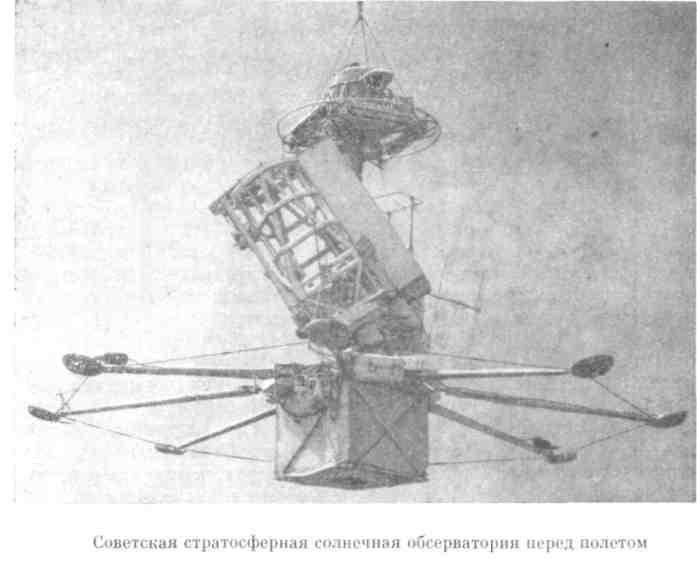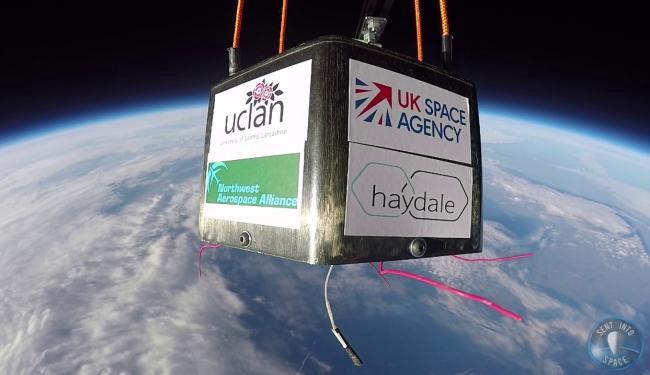What is explored in the stratosphere?
On April 12, we will send our server to the stratosphere. Soon we will write in detail about the technical stuffing of our project “ Space Data Center ”. In the meantime, we want to talk about why today use flights to the stratosphere.
 NASA Research Stratostatus
NASA Research Stratostatus
Cosmos is much closer than we think. And this is not a beautiful metaphor: today the boundary of the Earth’s atmosphere is taken at the level of 100-122 km. However, already at 30 km, in the stratosphere, 99% of the air mass remains below you. The last one percent of the air is “smeared” on the remaining 70–90 km altitude. For comparison, at sea level, the average atmospheric pressure is about 1000 millibars, and about 30 millibars per 30 km. Since the stratosphere is the “ozone shield”, the level of solar radiation is much higher in its upper part. Only the temperature is knocked out of the slender picture of the harsh, almost airlessness: from -75 ° for 12 km it rises to 0 ° for 45 km (sometimes it warms up to this temperature already for 30 km, although usually here -20 ...- 10 ° ).
')
Because of the combination of conditions, the altitude range of 30–40 km is sometimes called the “precosmos” and is actively used to conduct all sorts of scientific studies that require minimal atmospheric influence. That is, in the upper stratosphere one can cheaply conduct research and tests without spending on a full-scale spacewalk.
The world's first stratostatus was built by the scientist Auguste Picard to study cosmic rays. The nature of cosmic rays up to the 1940s. remained unclear. Studies of the interaction of cosmic rays with matter with the help of nuclear emulsions lifted on balloons led, in particular, to the discovery of new elementary particles — the positron (1932), muon (1936), and the π-meson (1947).
Nowadays, despite the title of “pre-cosmos,” the stratosphere is most often used to ... form weather forecasts. According to modern concepts, atmospheric processes occurring in the stratosphere have a very strong influence on the weather on Earth. Therefore, every day, at 12 and 24 o'clock in a single time, hundreds of weather probes are launched all over the planet: these are small balloons, under which small hardware blocks are attached, which as they rise into the stratosphere record the temperature and humidity of air, wind speed and direction. Information from weather probes is collected in a single information system and is used in weather forecasting models. For example, if today the air masses are moving from Africa to the north-north-east, then at that speed this atmospheric front will be in Europe in a couple of days, and so on.
Also in the stratosphere studies are being conducted in which the atmosphere interferes, and it is too expensive to go completely beyond its limits. And the atmosphere usually interferes with astronomers. Back in the 1950s, the first stratospheric telescope in the world with a 30 cm diameter main mirror was launched in the United States, which made images of the solar corona unsurpassed at that time. In 1966, in the USSR, an 8-ton platform with an automatic Saturn observatory set off for a flight of our luminary under a stratostat. The main mirror of its telescope was 50 cm in diameter (although structurally it was designed for a meter mirror).


Also telescopes operating in the X-ray and infrared ranges flew and fly in the stratosphere; for them, the influence of the atmosphere is much more destructive, since it absorbs such types of radiation.

Another of the interesting problems you can recall the study of silver clouds. This is a rare atmospheric phenomenon that appeared about 130 years ago, shortly after the eruption of Krakatau volcano. Noctilucent clouds form at an altitude of about 80 km, only from May to September and only at high latitudes. They become visible only when the sun is almost set and is 6-16 ° above the horizon.

Noctilucent clouds have been studied since they were first seen in 1885. It is still not known exactly where they come from. According to one of the versions, the smallest dust from a volcanic eruption hit the mesosphere, and its particles in certain conditions condense moisture on themselves and become visible. For several years, a fresh hypothesis has appeared that this methane rises to the upper layers of the atmosphere, interacts with cosmic dust and turns into ice crystals.
A great help stratosphere has in space exploration. The conditions there are very similar to space: the pressure is 100 times lower than at sea level, high levels of solar radiation, as the temperature rises a very strong temperature drop, which is also characteristic of space: the difference between the "solar" and "shadow" sides can reach 170 degrees
 Card used to transport bacteria on a stratostat
Card used to transport bacteria on a stratostat
So during one of the solar eclipses NASA conducted a study of the behavior of bacteria in an environment similar to Mars. The atmosphere of Mars on the surface is about 100 times smaller than Earth's, with cooler temperatures and more radiation. Under normal conditions, the upper part of our stratosphere is similar to the Martian conditions, and during a solar eclipse, the similarity with Mars increases. The moon suppresses the emission of radiation and heat from the Sun, blocking certain ultraviolet rays that are less common in the atmosphere of Mars, and lowering the temperature in the stratosphere even more. In general, the stratosphere is an excellent “sandbox” for testing various equipment and materials.
Another interesting stratospheric research area is testing satellite communications systems. Due to the sphericity of the Earth, the range of direct radio communication on the surface of the planet is limited to about 27 km, this distance to the horizon. And if you raise the transmitter into the stratosphere, then it will “beat” by several hundred kilometers, which is quite enough for field tests.
Biological experiments are also carried out in the stratosphere: they study the ability of various living organisms to survive in the conditions of a high radioactive background, which always accompanies astronauts outside our atmosphere.
But the people themselves are rare guests at an altitude of 30 km. Usually they are here only passing when they are driven by a rocket. In the 1950s and 1960s, several superhigh-grade stratospheric parachute jumps were made, but in the last 40-50 years there have been only two of them. The last of them, the most sensational, is the jump of Felix Baumgartner from a height of more than 36 km.
Pleasure is extremely expensive: we need a large stratostat, a lifting capsule, a spacesuit with a life support system - all together it costs millions of dollars.
Finally, one of the strategic directions in research is the search for structural materials that are most effective in terms of volume, mass and strength, since one of the most difficult and expensive tasks in creating orbital and planetary objects intended for people to stay is the delivery of large elements from the Earth. designs. And in the stratosphere they study the behavior of polymer composites, from which they plan to blow out (with subsequent curing) whole rooms in orbit, the Moon or Mars in the future. Scientists figured out how the material behaved during curing, at what speed, what properties it acquired. Also fresh can recall the study of carbon fiber material .

Of course, our new project " Space Data Center " will cost many, many times cheaper than the mentioned experiments. The launch coordination with the responsible authorities is in full swing. Most of the equipment arrived, the server is assembled and we link the components with each other.
Follow the news on the blog :)

We invite you to take part in our experiment and send your message on April 12 to our server in the stratosphere.


Cosmos is much closer than we think. And this is not a beautiful metaphor: today the boundary of the Earth’s atmosphere is taken at the level of 100-122 km. However, already at 30 km, in the stratosphere, 99% of the air mass remains below you. The last one percent of the air is “smeared” on the remaining 70–90 km altitude. For comparison, at sea level, the average atmospheric pressure is about 1000 millibars, and about 30 millibars per 30 km. Since the stratosphere is the “ozone shield”, the level of solar radiation is much higher in its upper part. Only the temperature is knocked out of the slender picture of the harsh, almost airlessness: from -75 ° for 12 km it rises to 0 ° for 45 km (sometimes it warms up to this temperature already for 30 km, although usually here -20 ...- 10 ° ).
')
Because of the combination of conditions, the altitude range of 30–40 km is sometimes called the “precosmos” and is actively used to conduct all sorts of scientific studies that require minimal atmospheric influence. That is, in the upper stratosphere one can cheaply conduct research and tests without spending on a full-scale spacewalk.
The world's first stratostatus was built by the scientist Auguste Picard to study cosmic rays. The nature of cosmic rays up to the 1940s. remained unclear. Studies of the interaction of cosmic rays with matter with the help of nuclear emulsions lifted on balloons led, in particular, to the discovery of new elementary particles — the positron (1932), muon (1936), and the π-meson (1947).
Nowadays, despite the title of “pre-cosmos,” the stratosphere is most often used to ... form weather forecasts. According to modern concepts, atmospheric processes occurring in the stratosphere have a very strong influence on the weather on Earth. Therefore, every day, at 12 and 24 o'clock in a single time, hundreds of weather probes are launched all over the planet: these are small balloons, under which small hardware blocks are attached, which as they rise into the stratosphere record the temperature and humidity of air, wind speed and direction. Information from weather probes is collected in a single information system and is used in weather forecasting models. For example, if today the air masses are moving from Africa to the north-north-east, then at that speed this atmospheric front will be in Europe in a couple of days, and so on.
Also in the stratosphere studies are being conducted in which the atmosphere interferes, and it is too expensive to go completely beyond its limits. And the atmosphere usually interferes with astronomers. Back in the 1950s, the first stratospheric telescope in the world with a 30 cm diameter main mirror was launched in the United States, which made images of the solar corona unsurpassed at that time. In 1966, in the USSR, an 8-ton platform with an automatic Saturn observatory set off for a flight of our luminary under a stratostat. The main mirror of its telescope was 50 cm in diameter (although structurally it was designed for a meter mirror).


Also telescopes operating in the X-ray and infrared ranges flew and fly in the stratosphere; for them, the influence of the atmosphere is much more destructive, since it absorbs such types of radiation.

Another of the interesting problems you can recall the study of silver clouds. This is a rare atmospheric phenomenon that appeared about 130 years ago, shortly after the eruption of Krakatau volcano. Noctilucent clouds form at an altitude of about 80 km, only from May to September and only at high latitudes. They become visible only when the sun is almost set and is 6-16 ° above the horizon.

Noctilucent clouds have been studied since they were first seen in 1885. It is still not known exactly where they come from. According to one of the versions, the smallest dust from a volcanic eruption hit the mesosphere, and its particles in certain conditions condense moisture on themselves and become visible. For several years, a fresh hypothesis has appeared that this methane rises to the upper layers of the atmosphere, interacts with cosmic dust and turns into ice crystals.
A great help stratosphere has in space exploration. The conditions there are very similar to space: the pressure is 100 times lower than at sea level, high levels of solar radiation, as the temperature rises a very strong temperature drop, which is also characteristic of space: the difference between the "solar" and "shadow" sides can reach 170 degrees

So during one of the solar eclipses NASA conducted a study of the behavior of bacteria in an environment similar to Mars. The atmosphere of Mars on the surface is about 100 times smaller than Earth's, with cooler temperatures and more radiation. Under normal conditions, the upper part of our stratosphere is similar to the Martian conditions, and during a solar eclipse, the similarity with Mars increases. The moon suppresses the emission of radiation and heat from the Sun, blocking certain ultraviolet rays that are less common in the atmosphere of Mars, and lowering the temperature in the stratosphere even more. In general, the stratosphere is an excellent “sandbox” for testing various equipment and materials.
Another interesting stratospheric research area is testing satellite communications systems. Due to the sphericity of the Earth, the range of direct radio communication on the surface of the planet is limited to about 27 km, this distance to the horizon. And if you raise the transmitter into the stratosphere, then it will “beat” by several hundred kilometers, which is quite enough for field tests.
Biological experiments are also carried out in the stratosphere: they study the ability of various living organisms to survive in the conditions of a high radioactive background, which always accompanies astronauts outside our atmosphere.
But the people themselves are rare guests at an altitude of 30 km. Usually they are here only passing when they are driven by a rocket. In the 1950s and 1960s, several superhigh-grade stratospheric parachute jumps were made, but in the last 40-50 years there have been only two of them. The last of them, the most sensational, is the jump of Felix Baumgartner from a height of more than 36 km.
Pleasure is extremely expensive: we need a large stratostat, a lifting capsule, a spacesuit with a life support system - all together it costs millions of dollars.
Finally, one of the strategic directions in research is the search for structural materials that are most effective in terms of volume, mass and strength, since one of the most difficult and expensive tasks in creating orbital and planetary objects intended for people to stay is the delivery of large elements from the Earth. designs. And in the stratosphere they study the behavior of polymer composites, from which they plan to blow out (with subsequent curing) whole rooms in orbit, the Moon or Mars in the future. Scientists figured out how the material behaved during curing, at what speed, what properties it acquired. Also fresh can recall the study of carbon fiber material .

Of course, our new project " Space Data Center " will cost many, many times cheaper than the mentioned experiments. The launch coordination with the responsible authorities is in full swing. Most of the equipment arrived, the server is assembled and we link the components with each other.
Follow the news on the blog :)

We invite you to take part in our experiment and send your message on April 12 to our server in the stratosphere.

Source: https://habr.com/ru/post/447248/
All Articles